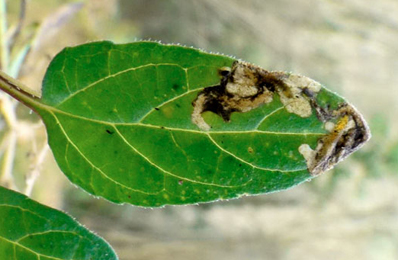|
||||||
|
VALERIANELLA. Cornsalads. [Valerianaceae] |
|
Nine species of Valerianella are recorded in Britain. These include the native Keel-fruited Cornsalad (V. carinata), Narrow-fruited Cornsalad (V. dentata), Common Cornsalad (V. locusta) and Broad-fruited Cornsalad (V. rimosa). Four British miners are recorded on Valerianella. A key to the European miners recorded on Valerianella is provided in Bladmineerders van Europa. |
Key for the identification of the known mines of British |
1a > Leaf-miner: A distinctive mine primarily above mid-rib, with irregular short lateral offshoots into leaf blade. Pupation external (Spencer, 1972: 51 (fig. 172), 55; Spencer, 1976: 270, 271 (fig. 486)). Branched, whitish, upper-surface corridor; main axis overlying the midrib; side branches overlying the main lateral veins. (In Campanula and Phyteuma the mine is much less branched, sometimes nothing more than a corridor on top of the midrib). Frass in rather long strings. Usually the mines begins as a long and narrow, shallow, tortuous lower-surface corridor that ends upon the midrib but otherwise is not associated with the leaf venation. Often this initial corridor is filled with callus, and then even less conspicuous. Pupation outside the mine. A linear mine on the upper surface, usually following the midrib and showing side branches along the veins. The frass is in strings. |
|
Liriomyza strigata (Meigen, 1830) [Diptera: Agromyzidae]. |
1b > Leaf-miner: Rather narrow corridor, untidy and sometimes branched, starting from the base of the leaf, in particular the midrib. Sides of the corridor irregularly eaten out, not really parallel. Frass mostly present, and then in a central line. The larva is capable of leaving the mine and start a new one elsewhere. These later mines are much broader, and the frass is scattered irregularly.. |
 Mine of Orthochaetes insignis on Prunella vulgaris Image: © Jean-Yves Baugnée (Bladmineerders van Europa) |
|
Orthochaetes insignis (Aube, 1863) [Coleoptera: Curculionidae]. |
1d > Leaf-miner: Mine not primarily associated with mid-rib. |
2a > Leaf-miner: Mine linear, whitish, both upper and lower surface. Pupation internal, at the end of the mine with the anterior spiracles projecting through the epidermis (Spencer, 1976: 433). Upper-surface, less often lower-surface corridor. Frass in isolated grains. Pupation within the mine, usually in a lower-surface puparial chamber. A long whitish upper surface corridor, which eventually goes lower surface. |
|
Chromatomyia horticola (Goureau, 1851) [Diptera: Agromyzidae]. |
2b > Leaf-miner: An irregular linear mine, which frequently follows the leaf margin, with conspicuous black frass (Spencer, 1972b: 51 (fig.162), 54; Spencer, 1976: 275). Corridor, often quite contorted, not infrequently a secondary blotch. Frass in strikingly long strings. Pupation outside the mine. |
|
Liriomyza valerianae Hendel, 1932 [Diptera: Agromyzidae]. |
| Last updated 08-Feb-2018 Brian Pitkin | ||
